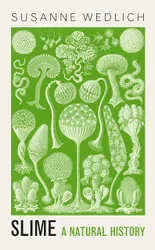Slime is a book about the goo that is produced and used by many organisms in the natural world. I hadn’t thought much about slime before, and perhaps the science of slime is a neglected area of study generally. This book aims to make us reevaluate how important it is for many organisms and natural processes on planet earth.
The book covers slime within our bodies, slime produced by microbes, slime in the oceans, slime on land, slime used as a defence against predators and pathogens, slime used to catch prey, slime in reproduction, and many other uses and types of slime. There are many interesting organisms and behaviours discussed in this book. For example, I liked reading about how slime is used to form colonies of microbes and was interested in the idea that these may have been a precursor to multicellular life forming.
For a book about slime, this book is a little dry. (Sorry.) There is not a single diagram or photograph in the entire book. It talks about many different species that I was unfamiliar with, and it was very hard to visualise these without pictures. I wanted the author to make a bit more effort to teach me about the processes and organisms, rather than just talking about them at length, and some well chosen images could have really helped. I’d like to see pictures of slime under the microscope and diagrams of chemical structures, as well as some photos or drawings of some of the slimy creatures mentioned.
The structure of the book is a little confusing too. The chapters weren’t particularly clear in their content, and I found it jumped around a lot and repeated itself a bit. I think it’s trying to take a similar approach to Periodic Tales, weaving in cultural and artistic topics with the scientific ones. But Periodic Tales was full of pictures, and the themes of each section and chapter were very clearly defined. In Slime, I got the impression that the author had too many ideas that they wanted to cover. I think a smaller number of well-chosen examples, covered in more depth, might have been more satisfying. The book was originally written in German, and some of the problems may have been with the translation into English. There were some long, quite confusing sentences in the book that I struggled with, and one or two things that didn’t make sense to me.
There are some things I would like to learn more about that the book doesn’t cover. I would have liked more on the chemistry of slime and how the composition affects whether it works as a lubricant or glue. It would be interesting to learn about the glands that organisms use to produce slime of different types, and how microbes can produce slime when they only consist of a single cell.
I did come away from this book with a new appreciation of slime and how important it is for just about every single organism on earth, as well as for the ecosystems in general. I like the idea of a book that goes poking around into topics that people haven’t considered before and sheds new light on the natural world as a result. There are some fascinating topics covered, and I really wanted to like this book. But it was quite hard work to read and in the end I found it disappointing. The author’s passion for slime is very apparent here, but it didn’t really rub off on me.
